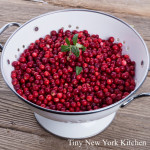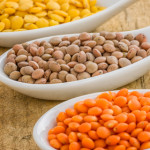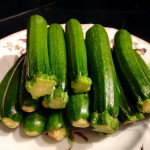The orange carrot we know and love today came originally from Holland, but up until the Middle Ages, all carrots were purple. Gardeners often delight in such oddities, but you will be very lucky to find any purple specimens available in stores or supermarkets.
Carrots contain large amounts of carotene and vitamin A, along with useful amounts of vitamins B3, C and E. When eaten raw, they also provide potassium, calcium, iron and zinc, but these are partly destroyed with cooking.
Almost all vegetables have a better flavor if they are grown organically, but this is particularly true of carrots. If possible, buy organic ones, or look for the young, pencil-thin carrots that still have their feathery tops attached. These young carrots can be eaten raw, or steamed for a few minutes. Older carrots should be unblemished and feel firm. Carrots should not be stored for too long, but they will keep for several days in a cool airy place or in the salad drawer of the refrigerator.
The age of carrots is a guide to how they should be prepared. The valuable nutrients lies either in or just beneath the skin, so if the carrots are young, simply scrub them. Medium-size carrots may need to be scraped with a knife before cooking them and large carrots will need to be scraped or peeled. Carrots can be cooked or eaten raw. To eat raw, they can be cut into julienne strips and tossed with a dressing, or grated into salads and coleslaw. They can bee cooked in almost any way you choose. As an accompaniment, cut them into julienne strips and braise in butter and cider. Roasted carrots are delicious, with a melt-in-the-mouth sweetness. Par-boil large ones first, but younger carrots can be quickly blanched or added direct to the pan with a joint of meat.
“Work With What You Got!”
© Victoria Hart Glavin Tiny New York Kitchen © 2017 All Rights Reserved
Figs are truly fantastic! Dried figs are available all year round and many markets offer luxuriously sweet fresh figs throughout the year as well. Figs are a healthy and portable snack that is packed with nutrition.
Figs are rich in potassium, which helps control blood pressure. They also provide calcium, magnesium, iron, and copper. Because they’re rich in fiber, figs support digestive health and may be helpful for managing a healthy weight. Figs are among the most alkaline foods and help balance the body’s pH.
Fresh figs are highly perishable, so they should be eaten a day or two after you purchase them. Look for figs that have a rich, deep color and are plump and tender, but not mushy. Wash them under cool water and remove the stem. Add fresh or dried figs to oatmeal, salads, cheese, and baked goods.
“Work With What You Got!”
© Victoria Hart Glavin Tiny New York Kitchen © 2017 All Rights Reserved
Cranberries
These tart, bright ruby-red berries grow wild on evergreen shrubs in peaty marshland all over northern Europe and North America. They are closely related to blueberries and bilberries, but are much more sour and are always served cooked. They are closely related to cowberries and lingonberries.
Cranberries are sometimes known as bouceberries since they were traditionally tested for firmness by being bounced seven times. Any berries that failed the bounce test were too squashy and were, therefore, discarded. Because of their waxy skins, cranberries keep for much longer than other berries, which helps to explain their popularity.
Cranberries contain useful amounts of vitamins C and D, potassium and iron. They used to be considered to be good protection against scurvy, and they are known to contain a natural antibiotic. Cranberry juice has long been recommended as a natural remedy for cystitis, kidney, bladder and urinary tract infections.
Look for plump, firm, bright, red berries and check the base of the carton in case of squashed or shriveled berries. Fresh cranberries will keep in the refrigerator for four weeks, or freeze them in plastic bags.
Cranberries can be used in both sweet and savory dishes or can be juiced and served as a drink. Their most famous incarnation is as cranberry sauce. The berries are high in pectin, so they make excellent jams and jellies. They also combine well with orange and apple, and can be mixed with blackberries and raspberries for an autumn version of summer pudding. Cranberry sorbet is a delicious treat. When cooking them for a sweet dish, do not add the sugar until the skins have popped or they will become tough.
“Work With What You Got!”
© Victoria Hart Glavin Tiny New York Kitchen © 2016 All Rights Reserved
Lentils
The lentil is a Eurasian herb grown for its small, flat, edible seeds and are considered a legume. They are lens shaped (the word comes from the Latin lens, “lentil”), variously colored on the outside, and yellow/orange on the inside. The earliest written mention of lentils is in the book of Genesis: Esau sold his birthright in exchange for a dish of lentils. Lentils are high in fiber, vegetable proteins, and complex carbohydrates and fairly rich in iron and protein; they are low in sodium and fat-free.
Work With What You Got!”
© Victoria Hart Glavin Tiny New York Kitchen
Baby Zucchini
Baby zucchini are very tender, tasty simple vegetables that have more flavor than the larger Italian zucchini as well as being very easy to prepare and enjoy. Archeologists think that they are indigenous to Central America. They are very nutritious and are a good source of Vitamin A, C B6, thiamin, niacin, and Pantothenic acid. Baby zucchini are also a very good source of fiber, protein, folate, iron, magnesium, phosphorus, zinc, and copper.
Quick Roast: Cut lengthwise and roast with sliced onions for 25 minutes at 350 degrees.
Blanching: Drop zucchini into boiling water for 1 to 2 minutes. Then remove to an ice bath. Zucchini are now ready to cut lengthwise and add to salads, sauté with mushrooms, onions, and garlic.
Grilling: Brush zucchini with olive oil, sprinkle with fresh herbs or spices, and either grill on BBQ or grill in a grill pan for about 2 to 3 minutes on each side.
Microwave: Place zucchini in ziplock bag. Cut corner of bag and microwave on high for 3 to 4 minutes.
For Salads: Baby zucchini makes a great salad addition. Shred or grate raw and add to salads, or cut lengthwise and add to vegetable platters.
Raw: To eat raw make sure to wash before eating.
“Work With What You Got!”
© Victoria Hart Glavin Tiny New York Kitchen










